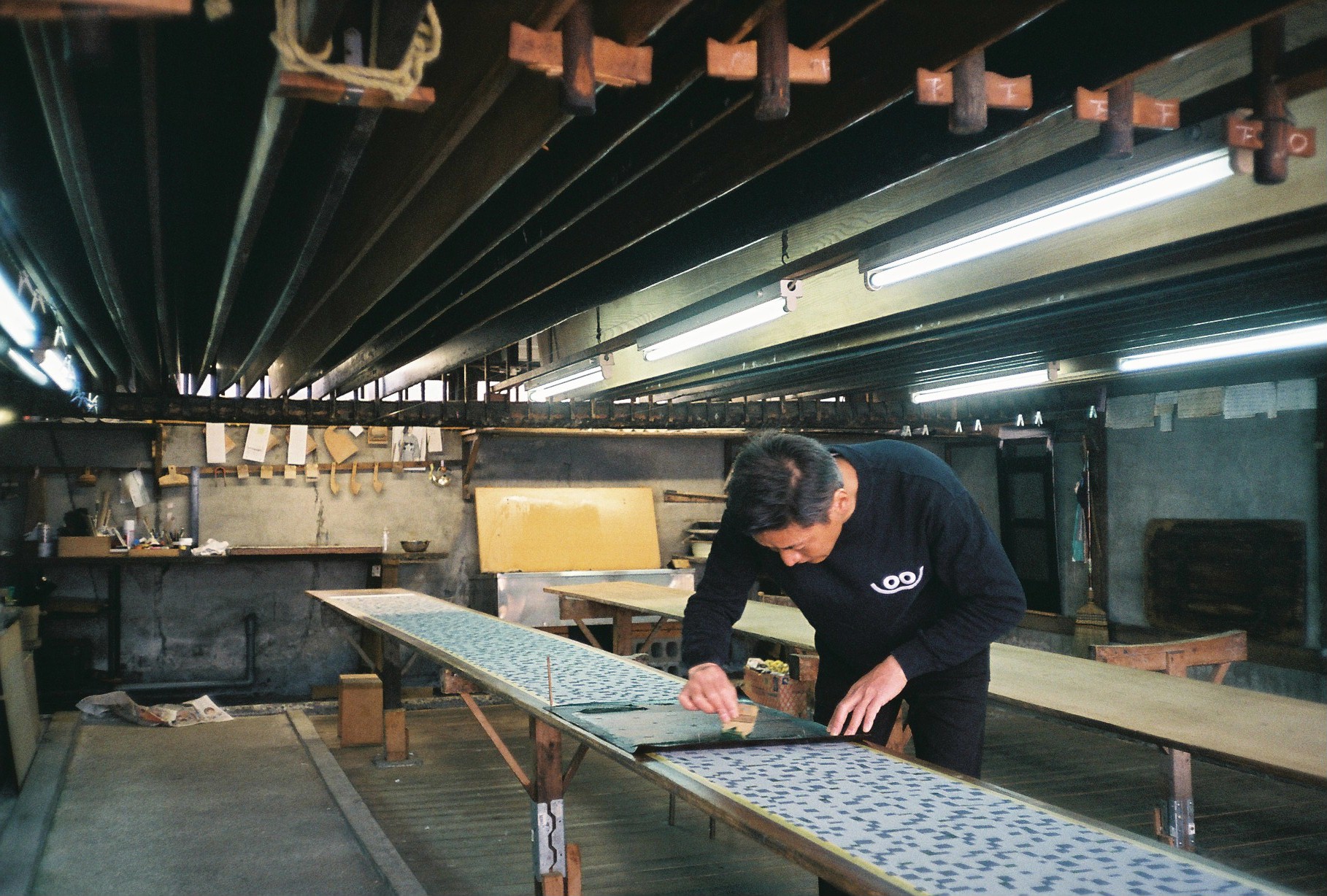
2023コレクションでは江戸小紋に焦点を当て、100年以上の歴史を持つ廣瀬染工場の四代目、廣瀬雄一さんにご協力いただきました。江戸小紋の魅力から、伝統工芸の後継問題、技術と芸術のバランスまで、eit swimが聞きたいことを廣瀬さんにインタビュー。
For the 2023 Collection, we focused on Edo-Komon and asked Yuichi Hirose, the fourth generation of the Hirose Dye-Works, which has a history of more than 100 years. We interviewed Mr. Hirose about ranging from the attraction of Edo-Komon to succession issues of traditional crafts and the balance between art and craft.
—-廣瀬さんは今、顧客や問屋さんから発注されて作っているのか、ご自身のクリエイションとして製作しているのか、どういう形でお仕事をされることが多いんですか。
廣瀬染工場はもともと着物問屋さんからの注文を受けて、その下請けとしてやっていました。が、僕の場合は主にクリエイションとして創ることが多いです。職人的な仕事の場合もありますけど、作家としての製作はやっぱり楽しいです。
—-作家としてどのように個性を出すのでしょうか。
もともとある古い型紙も、色を新しく調合することで新鮮に映るんです。逆にあえてクラシックな色でそのまま染める場合もある。まったく新しいデザインを型から起こす(型を型彫り師に注文する)ケースもあります。
—-What kind of work do you do nowadays, do you make products ordered by customers or wholesalers, or do you make them as your own creations?
Hirose Dye-Works originally received orders from kimono wholesalers and worked as a subcontractor. But in my case, I mainly create as a creation. There are times when I work as a craftsman, but I still enjoy creating as an artist.
—-How do you give your work individuality as an artist?
I use old patterns that have always existed, but by mixing new colors, I can make them look fresh. On the other hand, there are cases where I dare to use classic colors. There are also cases where a completely new design is created from a paper pattern.



—-江戸小紋の魅力を、廣瀬さん自身はどのようにお考えですか?
江戸小紋は東京の文化を象徴する染め物。徳川時代の質素倹約という状況下で自己表現として生まれて、京都の“雅”とはまた違う良さがあります。デザインがかっこいいか、かっこ悪いかというよりも、柄ひとつひとつに意味がありストーリーがあるということが重要だったんですよね。日本の工芸の良さはどことない素朴さにあると思っています。
逆にeit swimさんは今回なぜ江戸小紋がいいと思ってくださったんですか?
—-日本にはたくさんの素晴らしい伝統工芸があっても「伝統工芸」という響きだけでどこか「渋いもの」みたいに壁が生まれたり、日常生活からは遠いものになってしまっている感覚があります。実は日本伝統の柄や染め物って現代のファッションに落とし込んでも普通に可愛いんだということを示したくて伝統シリーズを始めました。江戸小紋はまさに日本人の美しさ、細やかさ、技術の高さの賜物。近くに寄って小さな点々だと気づいた時の感動がすごい。この粋な文化に惹かれました。
そう言っていただけて嬉しいです。「粋」という言葉も、英語でもフランス語でも直訳することができない、日本特有の文化ですよね。
—-What do you think attract you to Edo-Komon?
Edo-Komon is a dyed fabric that symbolizes the culture of Tokyo. It was born as a form of self-expression under the frugal and thrifty conditions of the Tokugawa period, and has a different quality from the “Miyabi(elegance)” of Kyoto. Rather than whether the design was cool or not, it was important that each pattern had its own meaning and story. I believe that the beauty of Japanese crafts lies in their uniquely simple nature.
But what made you think that Edo-Komon would be a good choice for this project?
—- Even though there are many wonderful traditional crafts in Japan, the mere sound of the word “traditional craft” creates a barrier, like something “old” or something that is distant from our daily lives. We started the traditional series to show that traditional Japanese patterns and dyed goods can be incorporated into modern fashion and still be cool. Edo komon is truly a product of the beauty, fineness, and skill of the Japanese people. It is a great feeling when you get close and notice that they are tiny dots. I was attracted to this “iki” culture.
I am glad to hear you say so. The word “iki” is also a uniquely Japanese culture that neither English nor French can directly translate.

—-その事実にもまた「粋」を感じます。江戸小紋は海外での評価も高いとか。
江戸小紋は19世紀ジャポニズムのときフランスに出ていきました。イギリスのウィリアム・モリスも影響を受けたと言われています。僕もパリで展示会や個展を行うと、こんなに細かい紋様は日本にしかない、と驚かれます。
—-その繊細な技術についてですが。上質な和紙があったことで発展したと以前お話ししてくださいましたよね。
はい、上質な和紙が日本の伝統工芸の原点だと思っています。あらゆる工芸の基礎になっているんじゃないか、と。江戸小紋の型紙も和紙でできています。上質な和紙とそれを細かく切ることができる刃物が日本にあったことでこの文化が生まれました。僕たちの型紙は和紙の中でも特に繊維が細かい美濃和紙を使っています。
—-代々受け継がれていく型紙が、こんなに薄い和紙でできていることに驚きました。
そうですよね(笑)。もちろん有限ですけど、そもそも和紙が丈夫だから成り立ってるんです。
—-This fact also makes me feel “iki”. I hear that Edo-Komon is also highly regarded overseas.
Edo -Komon went to France during the 19th century Japonism. It is said that William Morris of England was also influenced by it. When I hold exhibitions in Paris, people are surprised that such detailed patterns can only be found in Japan.
—-About your delicate technique. You mentioned before that it was developed thanks to the existence of high-quality Japanese paper.
Yes, I believe that fine Japanese paper is the starting point of traditional Japanese crafts. I think it is the foundation of all crafts. The pattern for the Edo-Komon is also made of Japanese paper. This culture was born in Japan thanks to the availability of high-quality washi paper and blades that could cut it into small pieces. Our katagami(pattern paper) is made of Mino washi, which has the finest fibers of all washi.
—-We were surprised that katagami, which has been handed down from generation to generation, is made of such thin Japanese paper.
That’s right (laughs). Of course it is finite, but it is possible because Japanese paper is strong to begin with.


—-そんな伝統工芸を受け継ぐ職人さんが少なくなっていると聞きます。
江戸小紋にも限らず、日本の伝統工芸の問題は後継者の育成にあります。展示会でパリに行って思いましたが、日本だけじゃなく世界で伝統産業の衰退が始まっています。大量生産、大量消費の世界では効率の良さを求めすぎているんです。
職人の生活が厳しくなり、伝統工芸の道で何世代もやってきている家族が、継ぎたくない、継げない、継がせたくない、となってしまっているのが現状なんです。
—-何か策はあるのでしょうか。
自分が今楽しいのは自由にモノを創れているからだ、と再認識しました。結局そこの一番星になって頑張っていくしかないのかなと。残ったものが最後勝つんです。僕ら職人が自力で突破していかなきゃいけない部分でもあるのかもしれません。
—-伝統工芸のアート性をもっと強くアピールしていくというのはどうでしょうか。
職人はつきつめると、アート性より技術性のほうが高くなる。技術が高いほど工芸としての価値も上がるんです。逆にアート性が高いと技術性が低くなりやすい。両立が難しいんですよね。
—-なるほど。廣瀬さんのようにクリエイティブに伝統工芸を表現したり、新しいことにチャレンジする職人さんがいると、その道がもっと魅力的に見えるような気がしました。
基本的には技術を守っていく、継承していくということが一番重要。これまで守られてきた先代たちの想いは大切にしていきたいんです。そのうえで新しいデザインや素材、コラボレーションを通して、手づくりの美しさをより広く伝えていけたらと思っています。
—-I hear that the number of craftsmen who carry on such traditional crafts is decreasing.
The problem of Japanese traditional crafts, not limited to Edo-Komon, is the training of successors. I thought of this when I went to Paris for an exhibition, but traditional industries are beginning to decline not only in Japan but around the world. In a world of mass production and mass consumption, there is too much demand for efficiency.
Craftsmen’s lives are becoming harder and harder, and families who have been in the traditional crafts for generations don’t want to take over, can’t take over, or don’t want to let their families take over.
—-Do you think there is any solutions?
I realized again that the reason I am enjoying myself now is because I am free to create things. In the end, I think I have no choice but to become the no.1 there and do my best. What remains will win in the end. Perhaps this is the part where we craftspeople have to break through on our own.
—-How about promoting the artistry of traditional crafts more strongly?
When craftspeople are pursued, their technical skills are higher than their artistic skills. The higher the skill, the higher the value of the craft. Conversely, the higher the artistry, the lower the technique. It is difficult to balance the two.
—-I see. I feel that if there are artisans like you who express traditional crafts creatively and challenge new things, the path to traditional crafts will become more attractive.
Basically, the most important thing is to protect and pass on the techniques. We want to cherish the ideas of our predecessors that have been preserved so far. At the same time I hope to convey the beauty of handmade products more widely through new designs, materials, and collaborations.


